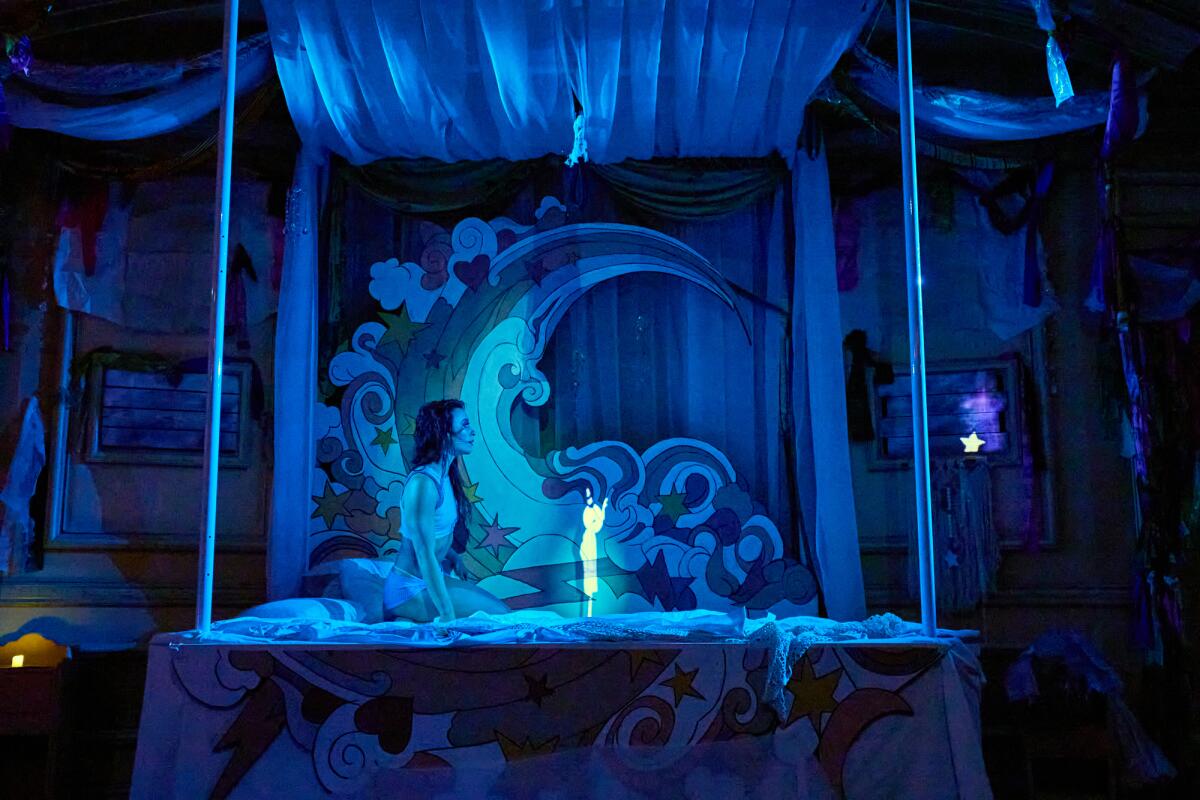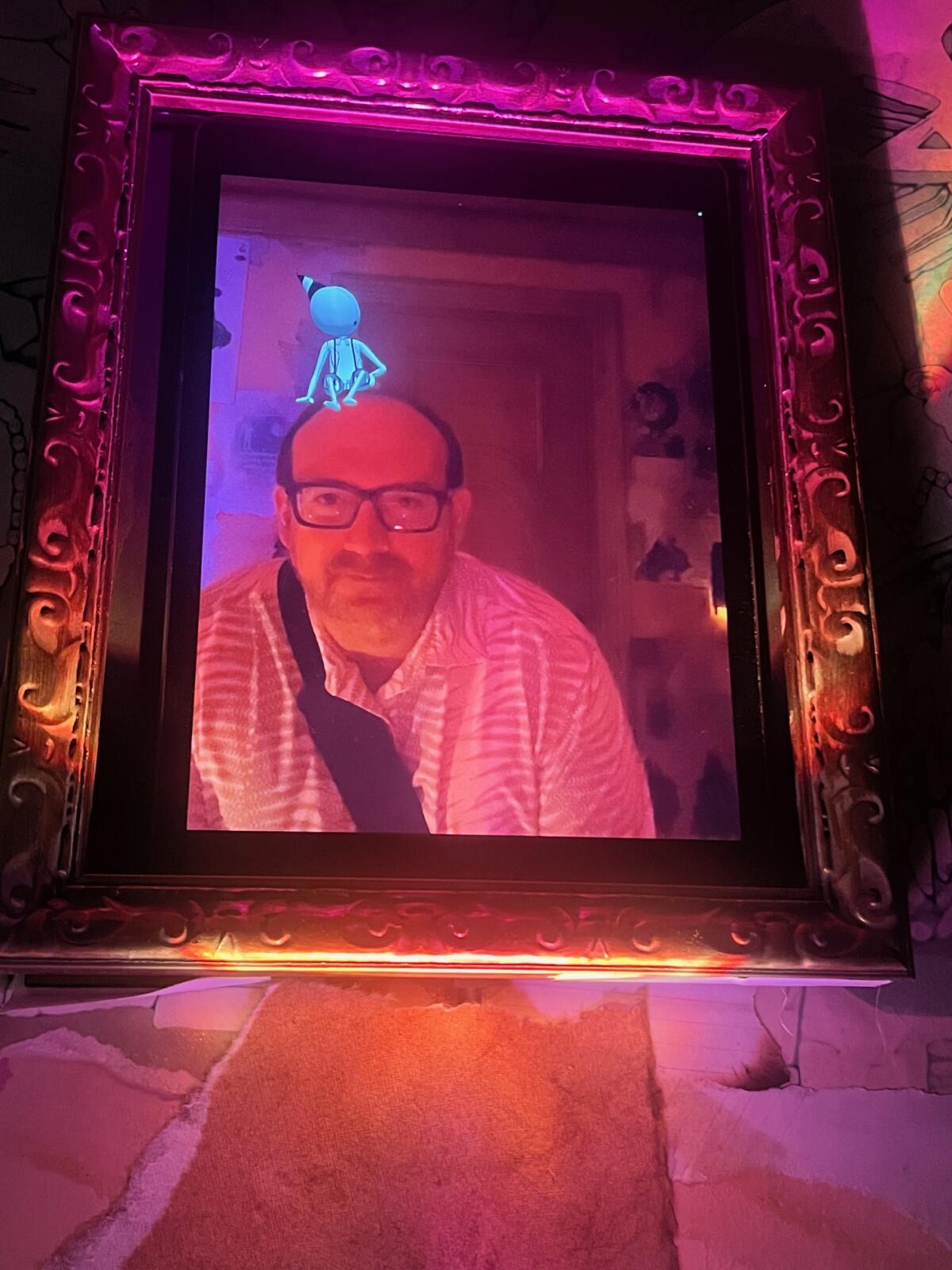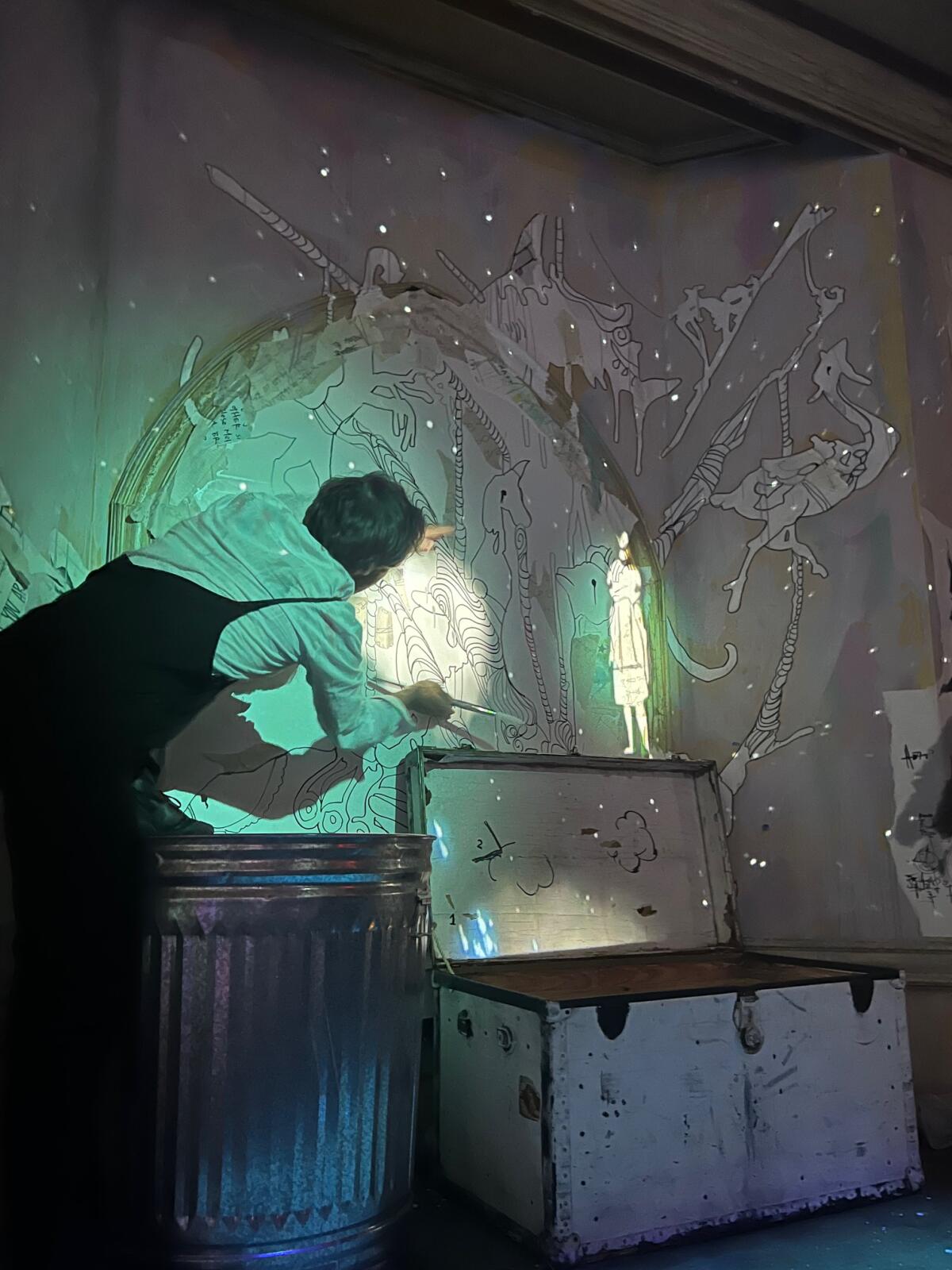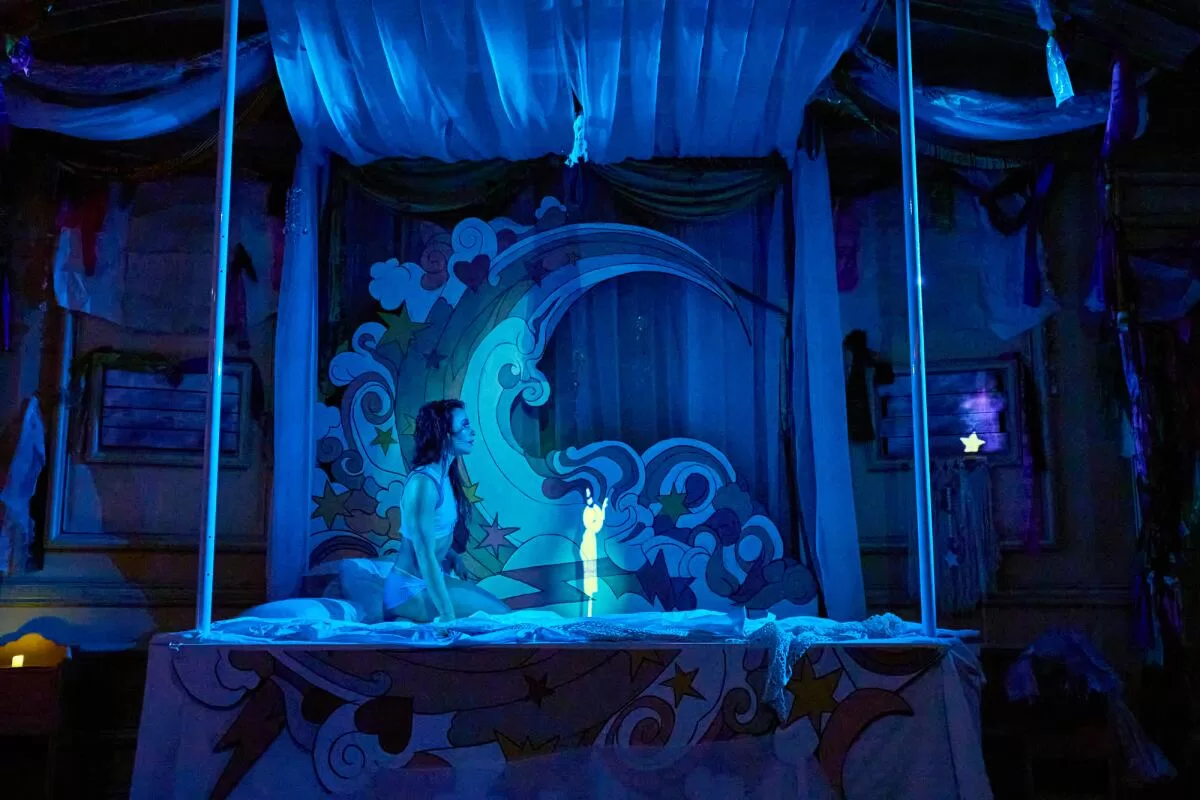Particle is his name, and he’s a glowing white figure with a circular head and a rectangular body, a mix of simple shapes that can convey an array of human emotions via elastic, exaggerated movements. Animation, rooted in imagination, has long had the power to amplify human feelings and heighten reality. But in “Particle Ink,” animation enters our reality, as Particle, for instance, leaps from wall to pillow, dashes across a bed curtain and even cries into a physical bucket.
“I wish I was 3-D,” Particle scrawls at one point on the wall, but the show makes us believe that he is vaulting among us. Look into a mirror, and Particle sits and walks atop our heads, becoming essentially a virtual animated pet. At one point, a dancer contorts herself as she carries Particle, tucked in a birdcage, across a room. Actors appear to hold Particle’s hand, and Particle even does battle with metaphorical demons, his projected body bounding across a room and swirling in and out of a toilet bowl.
Animation, with “Particle Ink,” has entered its live-theater era. It’s doing so via an exploration-focused production, meaning guests wander from room to room following actors as the acts unfold — or, in the case of “Particle Ink,” guests may be trailing animated figures or a puppet.
Think of it, then, as a sort of next-generation “Sleep No More,” New York’s long-running immersive production that is set to close this year. Only here, the theme is an original fairy tale rather than “Macbeth,” one where animation and augmented reality tools are used to explore our inner world, bringing it to life on walls, floors and furnishings with whimsical, highly active drawings that appear born of light.
Created by an enigmatic three-person creative team known as the LightPoets, a group with roots in Las Vegas, “Particle Ink” dates to 2017, when a proof-of-concept installation was shown at the Sundance Film Festival. It caught the attention of entertainment industry vets Jennifer Tuft and Cassandra Rosenthal, who, with their mixed-reality company Kaleidoco, have been working to bring “Particle Ink” to life. The show had a brief run in 2022 in downtown Las Vegas, but pre-pandemic it was planned for New York, where Kaleidoco once had a 10-year lease on a five-story Manhattan building targeted for the show.

(Particle Ink)
“We went big,” Tuft says, noting the group was about six weeks from loading when the COVID-19 lockdown began and altered the “Particle Ink” plans. Most of the initial costs proved to be recoupable or able to be redirected to a different space. “Particle Ink” now is committed to the Luxor Hotel & Casino for at least four years, residing in what used to be the hotel’s wedding chapel.
The inward-looking fantasy is set in multiple black-box rooms with minimalist furnishings — a communal, ritualistic hub, a library, a bathroom, a bedroom and a mini forest among them. The dancing is rigorous, with performers often seeming to be wrestling with themselves as they do battle with sometimes hidden (and sometimes not) existential demons. Fast-moving digital artwork comes alive on walls, much of it drawn via a wand, by a nameless artist, portrayed by Elenah Claudin, who serves as the show’s protagonist.
His rainbow-colored creations spring from a chest, and in one moment he turns a couch into a piano and in another sketches out a mystical horse and appears to gallop through his invented world. The images split the difference between something childlike and fanciful street art. Strategic use of projections among the sets allows the animation to appear tangible.
This merging of tech and animation into a believable landscape — what the LightPoets refer to as the “2.5 dimension” — is the triumph of “Particle Ink.” But it’s not the show’s heart. This is ultimately a story about loss, and searching to regain one’s footing after extreme grief. A black-lighted scribble on the wall in the show’s lobby spells it out: “Some of us are dead,” alluding to characters in the show that may live on only as memories or creative visions.
“It’s about everything from childhood wonderment to grief and loss, to really accepting yourself,” Tuft says. “It’s about striking a balance about reaching within and understanding oneself. These are concepts that don’t necessarily lend themselves to what people generally consider ‘Las Vegas entertainment.’”

Times Game Critic Todd Martens interacts with the animated character of Particle in the new Las Vegas immersive show “Particle Ink: House of Shattered Prisms.”
(Todd Martens / Los Angeles Times)
And yet here it is, complete with nods to mysticism, as well as tarot and oracle art. “Particle Ink” ultimately strives to tell a personal narrative about the journey to regain one’s creativity, relying primarily on movement and animation to do so. There is little dialogue outside a wandering puppet, a sort of wise man who can exist between worlds (or fill in narrative gaps for those who choose to focus on one of the show’s touchscreen-like walls and handful of augmented reality devices that further the adventures of Particle and his pals).
“Particle Ink” is a story of heartbreak. It follows the artist, his partner, Lilith (Dani Maloney), and the world he conjures. It pulls from age-old tales of light and dark, and how our minds are factories of fascination but also places of imprisonment. It also wants to remix the theatrical experience, as it not only heavily relies on technology but also takes influences from the world of gaming. A projection of a sword being drawn emerges on a wall, and then it becomes a prop for a battle scene. Its narrative too is quest-based, a journey for Particle to recover pieces of his creator’s shattered heart.

Animation comes alive via light and projections in “Particle Ink: House of Shattered Prisms,” a show that explores how an artist (Elenah Claudin) harnesses the power of creativity in overcoming grief and heartbreak.
(Todd Martens / Los Angeles Times)
Jo Cattell, a Chicago-based theater director and one third of the LightPoets, sometimes even intermingles the word “player” and “audience member,” noting that immersive theater only works if attendees quickly understand the rule-set of the creative work. While there’s no real onboarding in “Particle Ink,” the first scene builds to a communal ritual centered around light-gathering stones, one that allows our distressed artist to briefly tap into his creativity only to quickly lose it again. Particle, then, prods the audience on a journey of recovering his splintered heart.
I saw “Particle Ink” twice, the first night focusing heavily on interacting with the animation. Throughout the theatrical space are tablets that are reconfigured to look and feel like magic mirrors, further glimpses into the so-called 2.5 dimension. The second night, however, I decided to zero in on the narrative, and found both charm and anguish in the way Particle strives to heal his creator’s broken heart — Particle’s tiny size, playful nature and purposefully hand-drawn feel created a sense of fragility. Grief can be a stubborn place, but I felt moved in the way “Particle Ink” used creative tools — painting, creating and animation — to show how what we lose continues to live with us.
Thinking about the future of theater, Cattell wonders about today’s younger generations weaned on smartphones and games. While she says this isn’t a LightPoets thesis, she’s eager to experiment with ways to make theater a more active experience. The tradeoff is that the experience is less controlled, but those who go along for the ride can home in on certain characters or emotions. In theory, it creates a more personal show.
“I don’t want to call it a playground because I think that has connotations,” Cattell says. “But we definitely want people to play and create and have fun and enjoy, but at the same time watch something that might move them. Depending on who they are, or what moment of their life they’re in, it might break their heart.”
‘Particle Ink: House of Shattered Prisms’
Manifestations of grief and inner turmoil here emerge as giant characters outfitted as ink blots. The metaphor isn’t terribly difficult to uncover: With depression, and a loss of purpose, life is depleted of color. But it’s how the story is told that matters, and with a mix of animation and highly athletic dance, “Particle Ink” is 75 minutes of unexpected theatrical interactions. Cattell, for instance, estimates that there are about 10 hours of original animation, and creating a show in which performers would be interacting with walls and objects was a challenge.
“When you go to theater school, you don’t get taught to play with the walls,” Cattell says. “It’s been interesting coming from a theatrical background. We’re going to break rules. We’re breaking rules in storytelling, in genre and format. But there’s a reason those rules exist. How do we still make sure the performer is connecting with the audience when the performer is now turning away from the audience?”
The solution: Find a way for those wall-bound animated characters to break free. And then let them dance.
